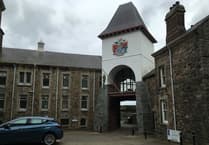The Wales Air Ambulance Charity has revealed that across 2023 and 2024, it was unable to attend 551 emergencies in Mid and North Mid Wales between 8pm and 2am.
During this period, there were 632 life or limb-threatening emergencies in total but only 81 received a Wales Air Ambulance response. This is because the current service is not configured in the right way.
Dr Sue Barnes, Wales Air Ambulance Charity Chief Executive, said: “Each emergency involves at least one person in a life or limb-threatening situation, so these figures are both heartbreaking and unacceptable. That is why we are undertaking an improvement to our service that will provide us with more opportunities to save additional lives.”
Thanks to the generosity of the Charity’s supporters, Wales has the UK’s largest air ambulance service. It has four helicopters and a fleet of rapid response vehicles, with dedicated NHS crews who attend people in a life or limb-threatening situation.
Wales Air Ambulance is consultant-led, taking hospital-standard treatments to the patient and, if needed, taking them to the most appropriate hospital for their illness or injury.
It is delivered via a unique third-sector and public-sector partnership. The Charity relies on public donations to raise the £11.2 million required every year to keep the helicopters in the air and rapid response vehicles on the road.
The Emergency Medical Retrieval and Transfer Service (EMRTS) supplies highly skilled NHS consultants and critical care practitioners who work on board the Charity’s vehicles.
Dr Barnes said: “Wales may have one of the most medically advanced air ambulances in the world but the current locations and operational hours mean we are not providing the best possible service with our current resources.”
Research has identified that the service is unable to get to between 2 to 3 patients a day (unmet need). Yet, perversely, its bases in Caernarfon and Welshpool are significantly underused.
In addition, the service only has one aircraft that operates overnight, covering the whole of Wales between 7pm and 7am. This is based in Cardiff. There is no air ambulance provision overnight based in Mid or North Wales and these regions are reliant on the Cardiff crew being available and able to fly.
At a regional level, over the two years of 2023 and 2024, the service was unable to attend 27 life or limb-threatening emergencies between 8pm and 2am and 89 missed emergencies in Gwynedd.
During the same period, there were 199 days when Wales Air Ambulance crews in Caernarfon did not see a patient. In Welshpool, it was 163 days without patient contact. Comparing this with the crews based in Dafen (28 days) and Cardiff (4 days), it is clear to see the significant underuse of the service’s current resources in Caernarfon and Welshpool.
One of the main reasons for this underuse is due to their locations on the peripheries of Mid and North Wales. Their locations, and the poor road networks that surround them, make it more difficult for crews to effectively use the rapid response vehicles when the aircraft is unavailable.
An independent review of the service, supported by medical and aviation experts, has made the following recommendations to improve its lifesaving work:
· The current resources in Caernarfon and Welshpool should come together in one base location in a more central position of North Wales, near the A55.
· Two teams that can respond by road or air will operate from the new base. To meet the pattern of demand, one team will operate between 8am and 8pm and another team will operate between 2pm and 2am.
How will this improve the service?
· Medics can attend more patients. This means more lives will be saved.
· Northern parts of Mid Wales and North Wales will get an overnight service closer to them, rather than relying solely on the current single overnight crew based in Cardiff.
· The service is making better use of its resources and using generous donations more effectively to benefit more people.
Addressing concerns raised by some people in the areas near the current bases in Caernarfon and Welshpool, Dr Barnes said: “The passion from these regions towards Wales Air Ambulance is overwhelming and something we are incredibly grateful for. However, there have been many misconceptions about this development, which have resulted in concerns about a reduced service or even a loss of service.
“Rural areas are seeing important public services closing in their communities, and I completely understand how people have interpreted the reconfiguration of our service.
“I can wholeheartedly reassure you that this is not about losing or reducing a service; this is about improving what we already have – particularly for those in Mid and North Wales. Our Charity would never do anything to cause people, and their loved ones, future harm.
From a medical perspective, Welshpool-based air ambulance medic Dr Stuart Gill said: “One of the most frustrating elements for us clinicians is knowing that there’s an emergency we can’t get to. Frequently, this happens with critically ill or injured patients in Mid and North Wales.
“Through the planned service changes, we expect to significantly improve attendance for those people we are currently missing.”
Caernarfon-based air ambulance medic Dr Mark Knights added: “We have very expensive, highly capable resources, and we want them to be used as much as possible for the people who need them.
“The service improvement will allow us to reach more people and save more lives. We hope that the generosity of people across Wales will continue as it makes a lifesaving difference. Something we can vouch for.”
One of the questions asked about this service improvement focuses on response times. People near the current bases in Caernarfon and Welshpool have raised concerns about longer response times.
Addressing this, Dr Gill said: “It’s an understandable question and I want to offer our reassurance to those concerned. The answer to the question is focused on the way that the Wales Air Ambulance operates. Firstly, we are not a primary responder. Our colleagues at the Welsh Ambulance Service will attend the scene first. We are a secondary responder, bringing the hospital to the patient if needed.
“Secondly, we are a pan-Wales service, not a regional one. As clinicians, we travel the length and breadth of Wales to provide lifesaving critical care – regardless of where we are based. We are a scarce resource and will go wherever we are needed. Therefore, our response times are not measured in the same way as the ambulance service. Not everybody has an air ambulance based in their region but they still have access to our service when we are operational.
“Finally, we deliver hospital-standard treatments to the patient on scene. By doing this, we’re already saving significant time (hours in some cases) for a patient to receive emergency department care compared to a standard response where advanced treatment would not start until they arrive at a hospital.”
From the pilot’s perspective, Captain James Grenfell, from the Charity’s aviation partners Gama Aviation, spoke about how the service improvement will be a “game changer”.
Captain Grenfell said: “We want to take the service to the next level in Mid and North Wales in a bid to save more lives, which is why we do what we do.”
Dr Sue Barnes concluded: “Put simply, this service improvement will allow us to save more lives, particularly in Mid and North Wales.
“We exist because of our supporters, and, with their continued support, our Charity will be there for them and their communities - now and always.”
For more information about the service improvement, please visit Service Improvement - Wales Air Ambulance.




.png?width=209&height=140&crop=209:145,smart&quality=75)
Comments
This article has no comments yet. Be the first to leave a comment.